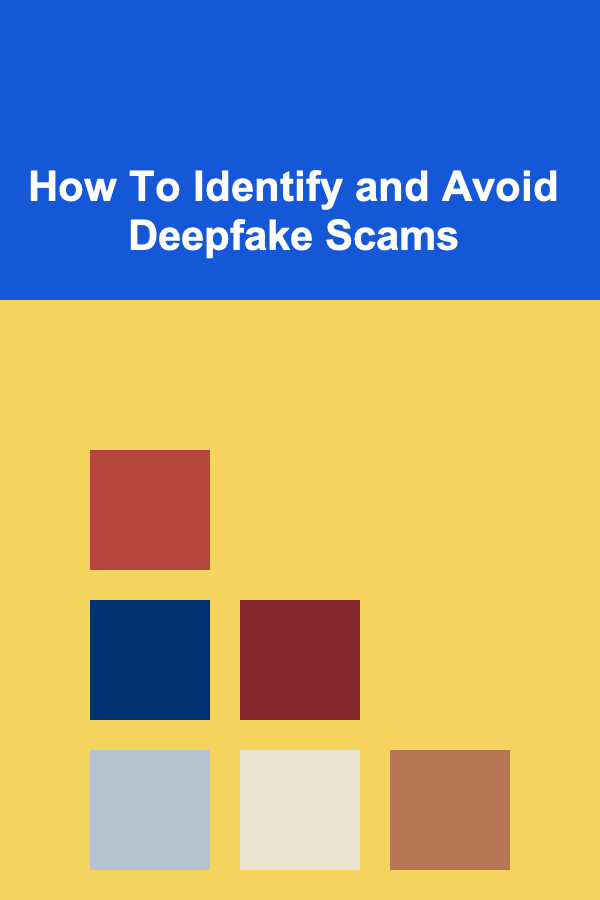
How To Identify and Avoid Deepfake Scams
ebook include PDF & Audio bundle (Micro Guide)
$12.99$9.99
Limited Time Offer! Order within the next:

Deepfakes, a blend of the words "deep learning" and "fake," refer to synthetic media created using artificial intelligence (AI) technologies, particularly machine learning models, to manipulate or generate video, audio, and images. These forgeries can be incredibly convincing, with the power to distort reality and deceive viewers in various ways, from impersonating politicians and celebrities to manipulating everyday individuals for malicious purposes. As deepfake technology advances, so too do the risks associated with its misuse, especially in the realm of scams.
Deepfake scams are a growing concern, as malicious actors utilize this technology to deceive, defraud, or manipulate individuals and organizations for financial gain, social disruption, or political influence. The deceptive power of deepfakes makes them a potent tool in the arsenal of fraudsters. With the proliferation of social media and digital platforms, it is essential for people to understand how to identify and avoid deepfake scams.
This article will delve into the concept of deepfakes, their evolution, and their impact on society. It will also provide practical tips on how to recognize deepfake scams and what steps can be taken to avoid falling victim to them.
The Rise of Deepfakes
What Are Deepfakes?
At its core, a deepfake is any piece of media---be it an image, video, or audio---that has been manipulated using AI or machine learning algorithms. The term "deepfake" originally referred to videos that were manipulated to depict someone saying or doing something they never actually did. However, as the technology has evolved, deepfakes have expanded to include synthetic images and audios that can convincingly mimic real people.
These deepfake technologies are primarily powered by deep learning methods, specifically Generative Adversarial Networks (GANs). GANs consist of two neural networks: a generator that creates fake content and a discriminator that evaluates how real the content appears. As the two networks continue to improve, the generation of increasingly realistic media becomes possible.
The rise of deepfakes is linked to the increasing accessibility of AI tools and the availability of vast amounts of digital data, such as social media posts, photographs, and videos. These tools can train AI models to recognize and replicate the appearance, voice, and mannerisms of specific individuals. As a result, deepfake videos or audios can be produced with a remarkable level of realism, making it difficult for the average person to distinguish the manipulated media from genuine content.
Deepfakes and Their Application in Scams
As deepfake technology has become more widely available, its application in scams has also grown. Fraudsters use deepfakes in a variety of ways to deceive people for personal, financial, or political gain. The most common types of deepfake scams include:
- Impersonation of Business Executives: Fraudsters can create deepfake videos of high-level executives, such as CEOs, speaking directly to employees or business partners. The scam might involve instructing recipients to transfer funds, disclose sensitive information, or execute fraudulent transactions under the guise of the executive's authority.
- Investment Scams: Scammers use deepfakes to create fake endorsements or video testimonials from celebrities or influential figures in finance. The fake endorsement may urge people to invest in a fraudulent scheme or cryptocurrency, convincing them that a trusted figure supports the investment.
- Identity Theft: Deepfakes can be used to impersonate individuals in order to access their private information, like social security numbers, bank account credentials, or passwords. The scammer might create a deepfake video or audio message that appears to come from a trusted source, such as a family member or coworker, requesting sensitive data.
- Blackmail and Extortion: In more malicious cases, scammers may use deepfake videos to create compromising or fabricated situations that involve the victim. For instance, a deepfake video might depict a person in an embarrassing or illicit scenario, and the scammer might demand money or other concessions to prevent the video from being released.
- Political Manipulation: Deepfakes can also be used to manipulate public opinion by creating fake speeches or debates from political leaders. These videos could be used to spread misinformation, influence elections, or incite civil unrest.
How To Identify Deepfake Scams
1. Check for Inconsistencies in Visuals
One of the most significant telltale signs of a deepfake is visual inconsistency. While deepfake technology has made significant advances, there are still common signs that the media might be manipulated. These inconsistencies can manifest in several ways:
- Unnatural Lighting or Shadows: Deepfakes often struggle with accurately replicating the way light interacts with a person or object. The lighting in deepfake videos might look artificial, with shadows that don't match the surroundings or seem overly harsh or absent.
- Odd Facial Movements: Deepfake videos often struggle to replicate natural human facial movements. Pay close attention to the face for any signs of irregularities, such as blinking that appears too fast or too slow, facial expressions that seem out of sync with the context, or unnatural mouth movements while speaking.
- Irregular Skin Texture or Distorted Details: The skin texture in deepfakes often appears blurry, overly smooth, or inconsistent, which can give the impression that the person in the video is not quite "real." Look for unnatural or exaggerated details, especially around the eyes, mouth, and ears.
- Inconsistent Backgrounds: In deepfake videos, the background or surrounding environment can sometimes appear distorted or unnatural. This can include flickering backgrounds, visible artifacts, or static objects that don't seem to align with the person's movements.
2. Analyze the Audio
Deepfake audio, while improving, still presents certain flaws that can help in identifying manipulated content. Listen for the following signs:
- Unnatural Tone or Pacing: Deepfake audio may feature inconsistencies in the tone or pace of speech. For instance, the speaker's voice may sound flat or overly robotic, or the rhythm of their speech may feel off. People usually vary their speaking speed based on context, but deepfake systems often fail to replicate these variations.
- Mismatched Lip Syncing: In video deepfakes, the audio might not match the mouth movements of the person speaking. Pay attention to the synchronicity of the voice and lip movements; if they don't match perfectly, it's likely a deepfake.
- Artificial Sounds: Look out for background sounds that don't quite fit. For example, the person might be in a noisy environment, but the audio doesn't carry the expected noises, such as distant chatter, background hum, or other typical sounds.
3. Verify the Source
One of the best ways to avoid falling for a deepfake scam is by verifying the source of the content. If you come across a video or audio clip that seems suspicious or out of character for the person it's allegedly coming from, here are some steps you can take:
- Check the Credibility of the Platform: Ensure that the content comes from a reputable platform or official source. Be cautious of content that has been shared by unknown accounts or on unverified websites.
- Consult Fact-Checking Websites : Many fact-checking organizations and websites, such as Snopes or FactCheck.org, actively monitor and debunk deepfake videos and other forms of misinformation. If you're unsure about a video or audio clip, consult these resources to check if the content has been flagged as fake.
- Cross-Reference with Other Sources: If the video or audio claims to show something that seems unusual or extraordinary, cross-check the event or information with other reliable news sources. If no other reputable outlet is reporting it, it may be a sign that the content is a deepfake.
4. Use Deepfake Detection Tools
Several software tools and services have been developed to identify deepfakes by analyzing the media's authenticity. These tools are designed to look for irregularities in the content that may not be immediately obvious to the human eye or ear. Some of the popular deepfake detection tools include:
- Microsoft's Video Authenticator: Microsoft's AI-powered tool can analyze videos and determine whether they are likely to be deepfakes by evaluating various characteristics.
- Deepware Scanner: This mobile app allows users to scan videos and images to detect potential deepfake content.
- Sensity AI: Sensity AI offers a comprehensive platform to identify deepfakes and other types of synthetic media across social media and other digital platforms.
By leveraging these tools, you can more effectively spot deepfakes and reduce the likelihood of falling victim to scams.
How to Avoid Falling Victim to Deepfake Scams
1. Stay Informed
Being aware of the existence and risks of deepfakes is the first step in avoiding scams. Stay updated on the latest developments in AI and deepfake technology, as well as current scam trends. Cybersecurity experts frequently provide insights on new threats, including deepfake scams.
2. Question Unsolicited Requests
If you receive an unsolicited video or audio message from someone you know or work with, especially if the message asks for sensitive information or financial transactions, approach it with caution. It's always wise to verify the request through another communication channel, such as a phone call or in-person meeting.
3. Educate Others
One of the most effective ways to combat deepfake scams is by spreading awareness. Educate your friends, family, and colleagues about the potential dangers of deepfakes and how to identify them. Encourage everyone to be skeptical of content that seems out of place or too good to be true.
4. Report Suspected Deepfakes
If you come across a deepfake, whether it's being used for scams or simply to deceive others, report it to the platform hosting the content. Most social media platforms and websites have mechanisms for reporting harmful or misleading content.
Conclusion
Deepfake technology is an exciting and rapidly evolving field, but it comes with significant risks. Deepfake scams are on the rise, and they have the potential to cause significant harm to individuals and organizations. Recognizing and avoiding these scams requires a combination of skepticism, technical awareness, and the use of advanced detection tools.
As deepfake technology continues to improve, so too must our ability to identify and protect ourselves from these deceptive tactics. By staying informed, questioning unsolicited requests, and using deepfake detection tools, individuals can avoid falling victim to deepfake scams and minimize the potential damage caused by this emerging threat.

How to Clean Your Oven with Natural Ingredients
Read More
How to Ensure Proper Citation and Formatting in Academic Articles
Read More
How to Sell Homemade Bath Bombs on Etsy: A Comprehensive Guide
Read More
How to Soundproof a Room with Minimal Disruption
Read More
The Legal Counsel's Toolkit: Practical Solutions for Legal Issues
Read More
Why Organizing Books Can Transform Your Space
Read MoreOther Products

How to Clean Your Oven with Natural Ingredients
Read More
How to Ensure Proper Citation and Formatting in Academic Articles
Read More
How to Sell Homemade Bath Bombs on Etsy: A Comprehensive Guide
Read More
How to Soundproof a Room with Minimal Disruption
Read More
The Legal Counsel's Toolkit: Practical Solutions for Legal Issues
Read More